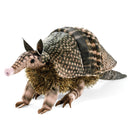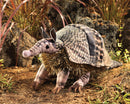Description
3207, Armadillo Hand Puppet from Folkmanis
Armadillos or "Little Armored One" are peculiar New World mammals, found only in the Americas. The amusing Folkmanis Armadillo puppet represents the colors, patterns, and banding found on these unusual critters. Custom printed on soft-boa fabric with a pine-needle "hairy" belly, the ingenious design curls up and secures with magnets. Use all five fingers to animate the legs and head. Recommended for ages 3+, 17" Long.
Fun Facts About Armadillos:
“The armadillo is the only known mammal to have a fully developed shell.” Armadillos Can curl into a hard, protective ball!
Resembling an armor-plated vehicle, the armadillo is outfitted with formidable protection against its natural adversaries and predators, which are unable to pierce the tough hide. This natural defense has enabled this creature to thrive for millions of years across the Western Hemisphere. Very few mammals can match its sheer resilience and survivability.
The term armadillo is derived from a Spanish word meaning “little armored one,” which was given by Spanish colonialists and explorers who spotted the unusual creature upon their travels through the Americas. The Aztecs had their own term for this creature: ayotochin, a word meaning turtle-rabbit.
Modern armadillos belong to the order Cingulata, a Latin word meaning girdle. It is believed that this order originated some 60 million years ago when South America was more isolated from the North American landmass. The entire order was once far more diverse, containing a multitude of different armored animals.
- The armored shell consists of overlapping scales known as scutes. These scales are made from keratin, a protein also found in hair and nails. Evidence suggests that this keratin is actually just modified skin that evolved for defensive protection.
- Armadillos are animals that are naturally susceptible to several human diseases, including leprosy.
- In human societies, armadillos are animals that have been traditionally used as food, clothing, and even musical instruments, and they are symbolic creatures in many different cultures. Rudyard Kipling brought this animal to greater worldwide prominence in his short story “The Beginning of the Armadillos” from his 1902 children’s book Just So Stories, in which it was featured as a symbol for cleverness.
- A group of gigantic armadillos with spiky club-shaped tails once roamed across the Americas beginning around 20 million years ago. Formally known as the glyptodonts, it is believed that they were as big as a Volkswagen Beetle. Despite their enormous size, they were actually grazing herbivores that lacked canine teeth. They appeared to go extinct around the last ice age more than 10,000 years ago.
Payment & Security
Your payment information is processed securely. We do not store credit card details nor have access to your credit card information.






